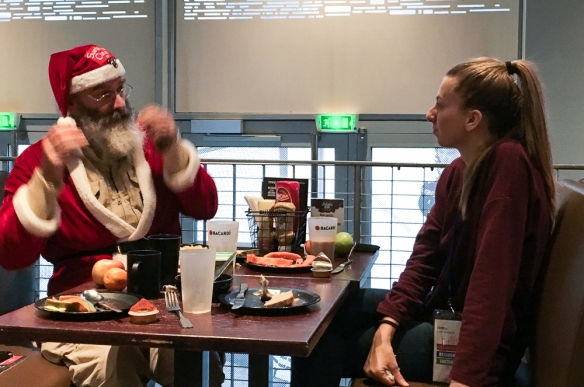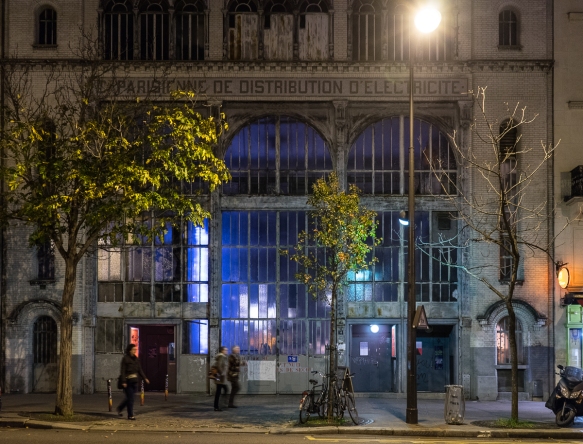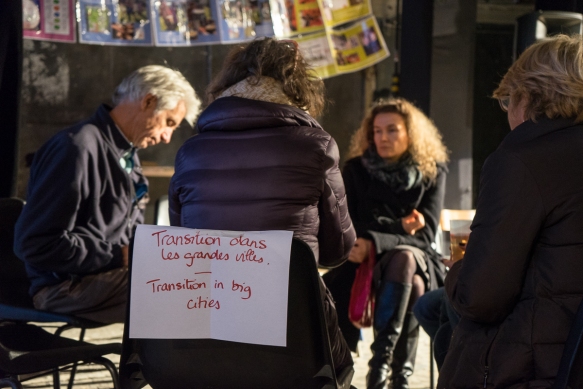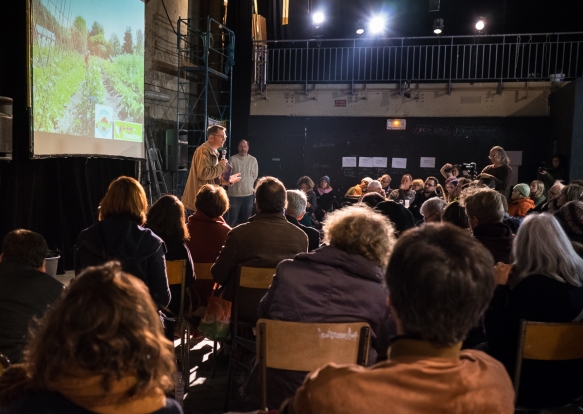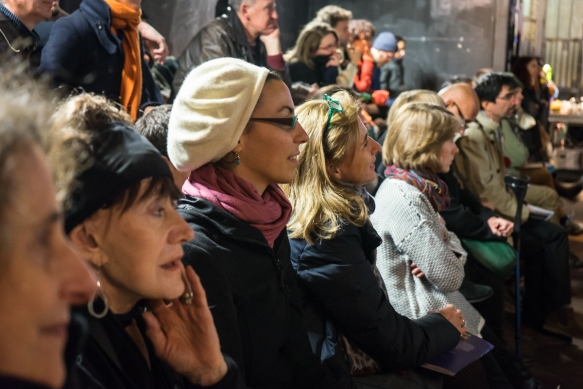Day 3: Monday – November 30th
Each day the creative minds of Place to B asked us to focus on a different message. Sunday’s topic was B the message and asked us to consider: Why doesn’t the environmental message come across? How can we involve citizens in changing the climate? How can we refresh the climate and rewrite the story?” I felt this was a theme that ran throughout much of the week as different groups met in the “Creative Factory” to work on various projects aimed at rewriting the climate narrative to be more effective.
And on this Monday the theme was, How shall we learn from the past? We were asked to take a look at the past, at the history of civilizations, at the meaning of progress, at the way we understand the notion of “transition” and “transformation.” This fit in well as a follow-up to the Transition Paris events I had attended on Saturday.
Every evening, there was Place to Brief – a live web-streamed TV show hosted primarily by Anne Sophie Novel and Joe Ross with help from other “correspondents” and many amazing guests. Since my French is a bit rusty and there were not always enough English-translation headsets to go around, I sometimes missed some of the content, but it was still interesting to sit in on these briefings with my climate colleagues.
I was fascinated by the corps of young female bloggers who, every briefing, sat on the floor against the walls of the room typing away. I admired their ease at doing live posts as the briefings were unfolding. With so much happening every day, I was pleased just to get out a few Instagram, Twitter, and Facebook posts while in Paris. This past week confirmed for me that I subscribe to the “slow blogger” movement.
At two of the TV briefings early in the week, I was in luck as several of the special guests were not only English speakers, but people whose work on climate change I greatly respect: On Monday night, Rob Hopkins of The Transition Network was fittingly brought in for the day’s theme of transitions and transformation. He was paired up with John D. Liu, who has a project entitled the Environmental Education Media Project and Barbara Glowczewski an anthropologist with the French National Scientific Research Centre whose work focuses on the indigenous people of Australia.
The conversations with these guests were mostly upbeat, recognizing the problems but focusing on solutions and the need to move forward. Rather than giving a full play-by-play of the briefing, I will share some of the inspirational comments from each of the guests:
Barbara Glowczewski stressed that we should pay closer attention to indigenous cultures since they have of years of experience that we can learn from. When asked what she thinks is the most fundamental, basic organizing principle for humanity, she replied, “It’s sharing.” In response to the question of what has value in the indigenous communities she studies, she noted that “songs, dance and storytelling are exchanged according to a system of law. You give them to someone else and they can then be transformed from generation to generation.”
John Liu: “In our current economic system, the things that are bought and sold are given a value but our natural resources are not. We’ve devalued the source of life. In order to have another outcome we’re going to have to move to this recognition that things are really happening. We need to understand these things and act on a planetary scale.”
“We can now look and see that climate regulation, fresh water, soil and water with zero pollution, biodiversity – this is where the real value is. And everything that’s ever been made [by humans] is worthless and ends up on the trash heap. If we were to base human economy on ecological function, than all human effort would go toward conserving, protecting, and restoring ecological function on the planet. And that’s what we need to do to have a regulated climate.”
“What is wealth? Wealth is not having more stuff but having more time so we can work less and spend more time with our families and friends. We need more time so we can have lemonade under the fig tree.”

Anne Sophie Novel and Joe Ross (on the left) listening to John D. Liu speak with Rob Hopkins at his side.
Rob Hopkins: “Early on [when starting the Transition movement] one of the most patronizing things someone said to me was ‘ Well you aren’t going to change very much with just a few community gardens.’” [Note: there are now over 1,000 Transition Initiatives worldwide.] We chose the word transition because we need to think about getting from where we are to where we need to be. Like a good permaculture design project, we design a process that removes as many obstacles as possible so that people can get the work done that they want to.
In response to the question: “ How do you go about empowering people?” Rob responded: “One way is that we recognize that as climate activists that we don’t just tell people about how terrible climate change is without giving them ideas of how to take a part in making things better…If you collapse people’s world view you have to stick around to help them pick up the pieces. We try to invite people to step into something and one of the ways [we do this] is by telling them stories about people like themselves.” [He then shared a couple stories from his new book 21 Stories of Transition which I had heard even more highlights from on Saturday night at a Transition Paris event.)
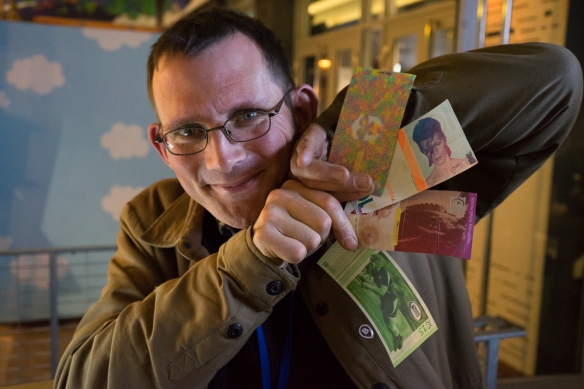
Rob Hopkins showcasing local currencies from Transition Network towns in the UK. Yes, that is David Bowie on the Brixton 10 pound note.
“We used to say that Transition was a response to the energy crisis, to climate change, to the economy. But now we say, Transition is a movement of people who are re-imagining and rebuilding the world. And you don’t always need to start with a problem up front, because what they are doing is sufficiently fantastic all over the world.”
And I have to agree. Despite all the terrible stories I heard while photographing the effects of climate change around the world for The Witness Tree, again and again, I was buoyed by tales of individuals taking steps to better their local world and communities coming together to problem-solve. I hope that our leaders who are making the decisions out at the COP listen to the stories that their delegates have to tell. I am sure they are fantastic.
Day 4: Tuesday, December 1st
In the afternoon I went to Gaîté lyrique for an ARTCOP21 roundtable discussion entitled: Culture and the Arts Engage with the Climate Challenge for COP21. The event was co-sponsored by COAL and was part of the opening day of the Summit of Creatives – “an opportunity to review the involvement of the cultural industry and inspire artists to get involved and put culture on the agenda of the negotiations.”
There were eight panelists including poet Kathy Jetnil-Kijiner from the Marshall Islands, Kevin Buckland from 350.org, American climatologist Cynthia Rosenzweig, and Teresa Borasino, Head of the festival Futuro Caliente in Peru (which took place during COP20 in Lima). The discussion revolved around how the cultural industry has had, and can continue to have, an impact on societal transformation.

Some of the panelists, from left to right: Cynthia Rosenzweig, Kathy Jetnil-Kijiner, Anne-Marie Melster, and architect Anna Heringer.
I was pleased to see Cynthia Rosenzweig, a senior research scientist at NASA’s Goddard Institute for Space Studies, included in this diverse group as I feel it is very important to bring artists and scientists together to help get across the climate message. I had first met Cynthia last June at a Climate sHeros event sponsored by The Human Impacts Institute in New York City and was struck by her friendliness. In this panel discussion, both her warmth and knowledge were apparent. She brought up the important link between science and art and acknowledged, “artists have been talking about ‘transformation’ for awhile and scientists are only now just catching on.” She noted her recent collaboration with Australian visual artist Shaun Gladwell: A Climate Change Hip-Pop Opera, as an example of how artists and scientists can intertwine their different languages to create a new language.
One of the other panelists, Anne-Marie Melster, co-founder and head of ARTPORT_making waves, was critical of the fact that officials at the COP made it very hard for artists to get involved with the actual conference. “You have to be connected with an NGO in order to get in…They think art is something that is just in museums. They live in their U.N box and don’t look outside of it.” Knowing I would not be able to get in to hear the actual COP negotiations was something that had originally deterred me from planning to come to Paris. But once I realized how many artists were going to be there making their voices heard through other activities, I was convinced it would be a worthwhile expedition. Ms. Melster was not completely negative. She ended by saying: “Don’t blame the people who don’t know about the arts. We can try to inspire them.”
I know I was inspired by this panel discussion and learned about some very engaging art projects including Artport and one called “The Blackmarket for Useful Knowledge and Non-Knowledge.” First started in 2005 by, Hannah Hurtzig, a Berlin-based curator and dramaturge, these one-night events are structured so that visitors can book 30-minute sessions with “experts” of their choosing (“natural scientists, craftsmen, artists, philosophers, and neighbors”) allowing them to visit a variety of people and topics during the evening. There was one held in Paris, on November 21st, as part of ARTCOP21. This 18th edition of the Blackmarket exchange and the first one to be held in France, asked visitors to bring a gift to give to the experts they wished to speak with instead of the usual symbolic fee of 1 euro. Subtitled: On Becoming Earthlings, several dozen experts met with visitors at the Musée de l’Homme and discussed “what does it mean to live in the Anthropocene?” I really wish I could have attended this event but even if the topic is not focused on the climate, I hope the Blackmarket makes it to New York one day soon.
Meanwhile back at Place to B, my home away from home for the week, the topic for the day was: How can scientists talk about climate change differently? A new social contract between scientists and society is needed. Its purpose? Produce more engagement with climate policies.
At the Place to Brief live TV show that night the featured guests were Naomi Klein – author of This Changes Everything and scientist James Hansen whose book, Storms of My Grandchildren, along with Bill McKibben’s The End of Nature and Eaarth provided some of the early inspiration for my Witness Tree project. Also on the docket were Nicolas Hulot, Didier Pourquery, Ghislain Bardout, and opera singer Barbara Hendricks.
Each of these guests were very emphatic about the fact that things need to change now. We must stop burning fossil fuels – not only at the rate that we currently are – but at an even more reduced rate than has been proposed by many of the countries at COP21. The window of time that we used to talk about as our safety net (IE – we have until 2050 to reduce emissions) has closed in on us. If we want to reduce the warming to a maximum of 2 degrees Celcius (3.6 degrees Fahrenheit) as scientists have has stated is the only way to keep things in check, we must sharply curb emissions. Hansen, in a slideshow presentation entitled: Climate (In)Justice and Governmental (Dis)Honesty argued that at this point we don’t need “cap and trade” but an actual carbon tax to be levied against the oil, gas and coal companies.
Hansen worked for NASA for 46 years before retiring in 2013 to be able to become a more vocal climate activist. “As a government employee, you can’t testify against the government,” he said in an interview with the New York Times. I had already been planning to hear him give a presentation later this month back in New York, so it was a treat to get to meet him (albeit briefly) that night at Place to B even though it turned out to not be my only encounter with him during the week.

